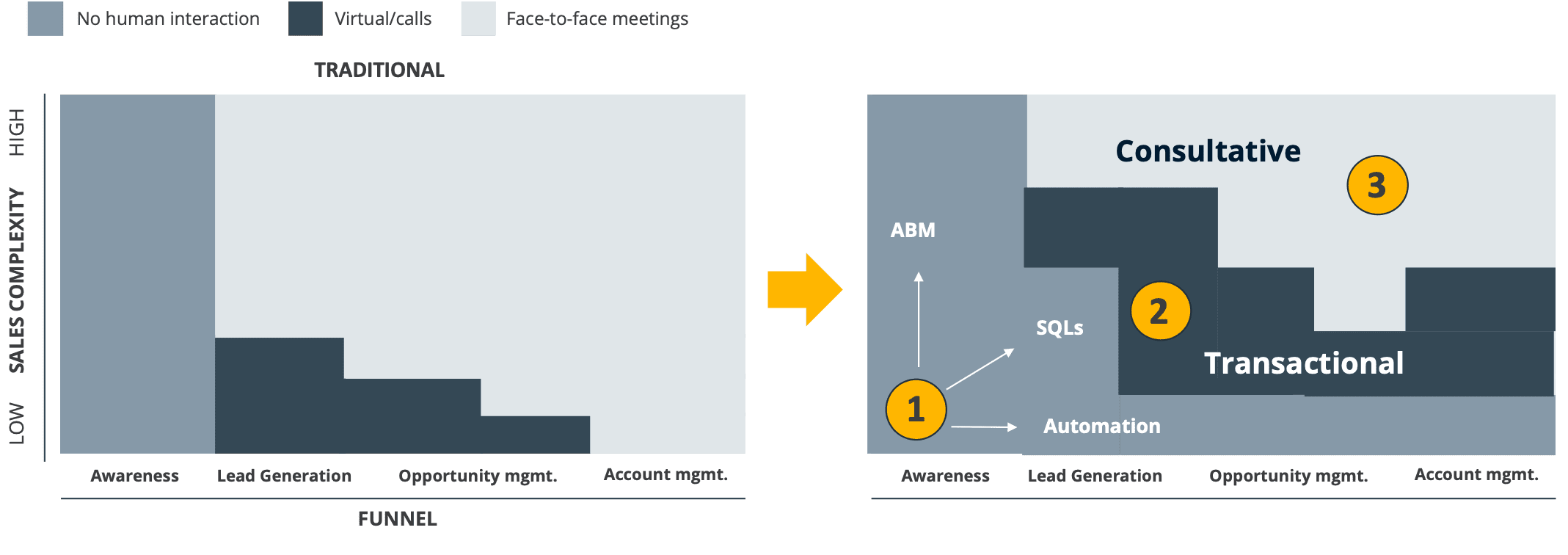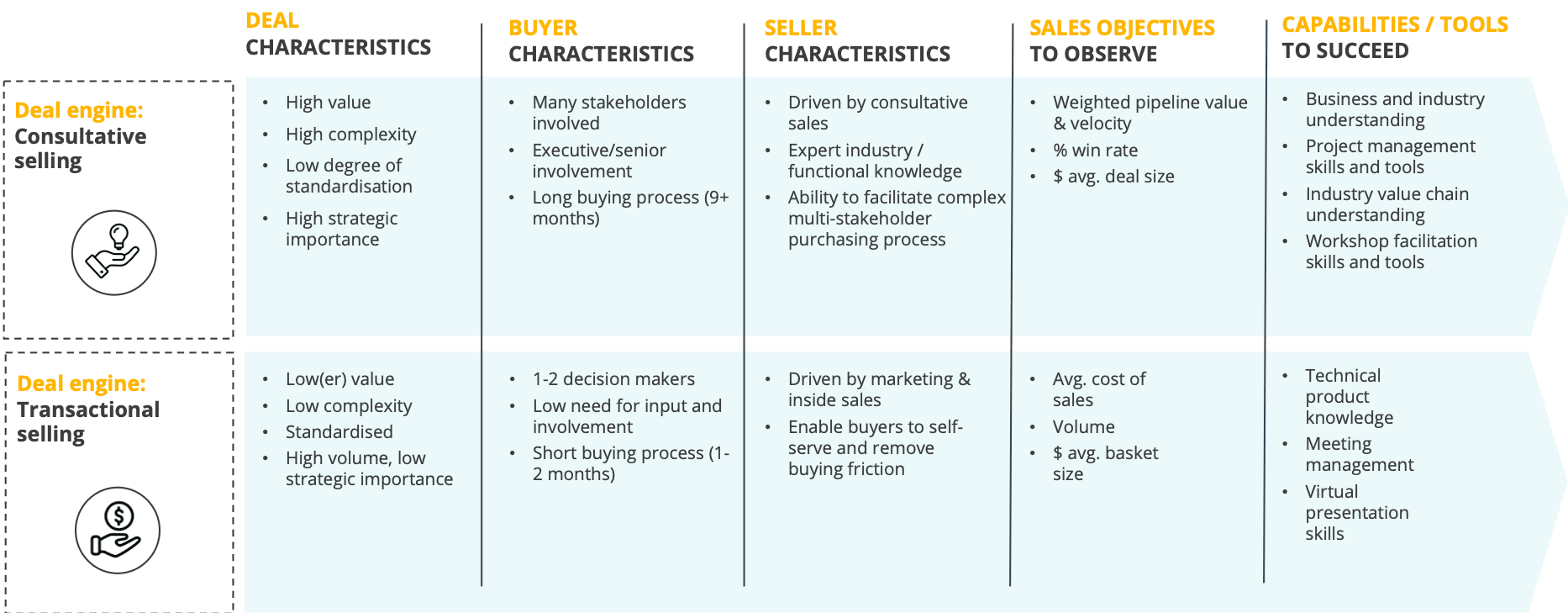Sales organisations will need to find their feet in a new normal. The new normal is shaped by a shift that has been underway for quite some time but the speed of change has been greatly accelerated by the recent COVID-19 outbreak.
To stay competitive, commercial leaders will need to radically transform rather than merely adjusting the way they work.
A new sales & marketing paradigm for BTB companies is emerging
Traditionally, the B2B commercial function would work in ways that would be tightly aligned with the theoretical and linear buyer journey we all know and love:
- Marketing would be responsible for ensuring awareness with its primary attention directed toward identity, branding and an element of supporting sales with sales collateral for meeting activity
- Sales would be responsible for establishing relationships, open up new accounts and drive sales opportunities on new and existing accounts sometimes supported by telemarketing for lead generation and the closing of simpler transaction
- Customer service would be responsible for answering non-technical questions, handling claims and support day to day issues and essentially end up reactively putting out fires
Over the past couple of years, enabled by deep understanding of the technological advancements and shifting customer behavior, some companies have experienced stunning growth rates by proactively changing the traditional way of working in the commercial function:
Exhibit 1
The Changing Commercial Function

- More can be done without any human interactions as Marketing are able to assume more funnel responsibility, participate in building pipeline value and even generate direct sales in the lower end of the complexity spectrum through e-commerce and self-service platforms.
- Virtual interactions grow in importance as B2B buyers demand more effective ways of engaging with the selling organization for less complicated transactions. This development has been on the rise for years and has been accelerated due the inability to meet, caused by the COVID-19 outbreak.
- Products and solutions grows in complexity and more stakeholders are involved in buying decisions than ever before. As high stake deals require proof of value and c-level attention, consultative selling becomes an even more important capability for selected parts of the sales organization to master.
Although parts of the traditional sales process (for both efficiency and better experience reasons) are continuously being digitalized and automated leaving no human interaction, the typical B2B company will still need to handle human led sales processes in the future. So, what must B2B sales leaders pay attention to when structuring their sales force for the future?
Sales in 2020 – A tale of two worlds
Over the past decade, the world of buying has changed dramatically. Insights and statistics from research companies have revealed a new landscape for how B2B companies get inspired, make decisions, and carry out purchases:
- Buyers are 75 % through the buying journey before they reach out to vendors due to self-education
- For the past 10 years, more and more stakeholders are involved in the buying committee, with an average of 6.8 stakeholders today
- Almost 15 % of the time in buying committees is spent on handling conflicting information. With the vast amount of information online, it is complex to reach final decision as more people are involved, with their own uptake of information
- 77 % of buyers report high purchase difficulty
While these insights and statistics are all pointing to the fact that buying and selling are becoming more complex it is not necessarily very helpful, unless you look a little deeper.
When sales leaders are making decisions on how to structure and design a salesforce to fit the new buying landscape it is important to bear in mind that averages will be averages and that statistics carries an important level of nuance not represented in numbers.
Exhibit 2
“B2B buying behavior is a polarized world, resulting in two growing extremes: transactional and complex buying “

When looking more closely at the world of B2B buying it becomes evident that much of it is more and more resembling that of buying in B2C. B2B buying is becoming increasingly easy with faster and more convenient e-commerce websites and self-service platforms, with little to no transactional costs.
Conversely, when turning to the more complex purchase, it seems to be getting even more difficult despite the increase in detailed information and number of sources available. Buying committees are getting bigger, sales cycles longer and buyers experience a significant increase in time spent handling conflicting information.
Two different buyer journey-based selling approaches
The increasingly polarizing behavior in the world of B2B buying is changing the requirements for how B2B companies should design their salesforce. The polarization requires B2B companies to organize the sales approach around two deal engines and as consequence take the first steps to recast the traditional field seller into either a more transactional sales role or upskill to a consultative seller.
Transactional selling
Simply put, a transactional oriented seller’s job is to handle a large amount of smaller deals and essentially do what they can to remove any friction from the buying process. When purchases get transactional, the effective B2B company will understand that buyers know this type of purchase is not strategically important and generally do not value seller involvement. Effective B2B companies will support buyers in this type of purchase by enabling them to do as much self-serving as possible through technological platforms and only add salespeople involvement intelligently where necessary to deliver an extraordinary experience and/or a more smooth process.
For the transactional seller to succeed, he/she must have superior technical product knowledge, be able to provide fast support handling any transaction issues to speed up the process, minimizing cost of sales and maximizing buyer’s basket size.
Efficiency is the keyword for the ideal transactional seller.
It is worth highlighting, that transactional sellers are by no means the equivalent to the traditional telemarketer. They need a firm level of expertise within the area they cover and the ability to transfer deals to their consultative seller-counterpart, whenever the deal characteristics require consultative interaction as they become more complex. But the fast and convenient buyer experience is the main driving force of the transactional purchase, which sellers must recognize and meet.
Consultative selling
Conversely, the ideal consultative sellers are spending much more time on few, and more complex deals. This requires the consultative seller to sometimes fill in the role of the buyer’s project manager to facilitate complex multi-stakeholder processes with executive involvement, as the purchase is often of high strategic importance. These deals are always larger purchases of solutions or projects with severe business implications for the potential client. Win rates and average deal size should be key metrics, as these deals usually take up a substantial part of resources and significantly influences the company’s revenue-creation. The consultative seller is required to have deep domain expertise including strong business and value chain understanding, and workshop facilitation skills and tools.
Effectiveness is the keyword for the ideal consultative seller.
We have summed up the difference between the two types selling in the illustration below:Exhibit 3
Two Primary Types of Selling: Consultative & Transactional Selling

One company – two ways of selling
It is a rare occasion to meet a company that only needs to consider either transactional or consultative selling. Most B2B companies need to be able to handle both the simple product sell and the more complex and time-consuming sell of a solution. When working with these two sales approaches simultaneously, it is important to not fall into the trap of allocating accounts into either a transactional or complex buyer “bucket”. Accounts may act as transactional buyers at one point and other times as complex buyers, even with the same vendor. We recommend not to fall into the trap of categorizing buyers into either transactional or consultative selling, as this can damage future deal opportunities. Categorization needs to happen at deal level and sales teams need to work cross-functionally to work optimally and avoid getting stuck in the middle.
Transforming the way, you sell
We see five transformation requirements that B2B sales leaders should pursue to transform their deal engines in the changing landscape:
#1 Organize around expertise, not geography
Organize your salesforce around expertise simply because the need for deep expertise is becoming imperative for B2B buyers. Whether it is strategic, functional, business, or industry type of expertise that is needed is up to each B2B organization and their value proposition to assess. Instead of allowing geography to be your default organizational principles, allow the expertise your buyers require to be the driving force. This is not only relevant to consultative selling but also possible and affordable through centralized transactional selling as most purchases revolve around online purchasing and remote customer success.
#2 Develop sales capabilities around the two types of selling, not a uniform approach
When observing the needed sales capabilities with more granularity, ask yourself if you are applying sales training programs based on the capabilities of “the average salesman” Are skills and tools too generic to fit today’s reality? If you are considering aligning salesforce design and deal engines with how modern buyers buy, your capability development needs to follow suit.
#3: Specialized sales managers, no one-size-fits-all approach
The traditional view of a sales manager is that he/she needs to be excellent at a few certain disciplines. Traditionally, a sales manager should be able to sell when needed ie. act as a role model, be great at sales coaching, and providing feedback as well as leading a team through the continuum of changes that meets most sales organizations on a regular basis in this day and age.
To a large extend, sales managers still need these disciplines in the new environment. However, if you choose to align your salesforce design to the changing buying environment, it requires the sales manager to have further specialization depending on if he/she is leading a more transactional or consultative sales team. In the transactional, a good analogy for the sales manager is the “conductor” i.e. keeping the rhythm in the sales department. Paying attention to and observing performance becomes key as well as skills within communicating and handling change. A good analogy for a leader of a consultative salesforce is a “lead pianist” whereas this requires a more intuitive, creative, and ready to improvise manager that knows how to coach and strategize around deals and act as a mentor.
#4: Technology as an enabler of better customer interactions, not measurement & reporting only
Implementation of new technology platforms in sales is often not firmly grounded in the core commercial agenda and is merely utilized to support better reporting on metrics that simply cannot be managed properly. Furthermore, the tendency to utilize technologies simply because of its newest capabilities and functions is a driving trend. Instead, seek to utilize technologies from a buyer-first perspective, and utilize the chosen technologies and tools to report on customer-focused metrics that can be managed.
#5: Close Sales & Marketing collaboration, no working in silos
Ultimately, close Sales & Marketing collaboration is of the essence if B2B companies are to transform their deal engines as a whole. Regardless of how capable your transactional and consultative sellers are, B2B companies cannot reach their fullest potential if sales don’t allow Marketing to bring value into the deal engine. Conversely, Marketing needs to proactively assume responsibility for docking into the sales process with market and customer insights, materials, building customer-friendly sales presentations, etc.
Accept that Marketing plays an essential and growing role in the transactional purchase, as setup of self-service platforms often lies in the marketing department.
It is not likely that a transformation of the deal engine will be a painless change – you need to review how you organize, manage, hire and develop your sales reps in this two-speed model – but sticking to the “stuck-in-the-middle”-status quo maybe even worse.









